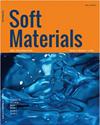Droplet size controllable fabrication of Pickering emulsion stabilized by soy protein isolate-carbon nanotubes/carboxymethyl cellulose sodium
IF 1.4
4区 材料科学
Q4 MATERIALS SCIENCE, MULTIDISCIPLINARY
引用次数: 1
Abstract
ABSTRACT Pickering emulsion plays an important role in various industrial fields including food, catalysis, and bioscience. Soy protein isolate (SPI) has been proved feasible for stabilizing Pickering emulsion after modification, though such methods were either difficult to proceed or application restrictive. Herein, we report a simple fabrication of oil-in-water Pickering emulsion using a complex of SPI and carbon nanotubes (CNTs)/carboxymethyl cellulose sodium (CMC-Na). The stability of our emulsion could be kept at a wide range of CNTs diameter, oil fraction, and pH, while the emulsion droplet size might be controlled through the tuning of pH and dispersed phase solvent as well. A strong interaction between SPI and CNTs/CMC-Na is a key factor for the homogeneous distribution of CNTs at the aqueous–organic interface, which benefits the Pickering emulsion formation. Our work will offer some useful thoughts for improving the stability of protein-integrated emulsion.大豆分离蛋白碳纳米管/羧甲基纤维素钠稳定Pickering乳液的液滴尺寸可控制备
皮克林乳液在食品、催化和生物科学等工业领域发挥着重要作用。大豆分离蛋白(SPI)已被证明在改性后稳定Pickering乳液是可行的,尽管这种方法要么难以进行,要么应用受到限制。在此,我们报道了一种使用SPI和碳纳米管(CNTs)/羧甲基纤维素钠(CMC-Na)的复合物简单制备水包油Pickering乳液的方法。我们的乳液的稳定性可以在较宽的CNTs直径、油分和pH范围内保持,而乳液液滴的大小也可以通过调节pH和分散相溶剂来控制。SPI和CNTs/CMC Na之间的强烈相互作用是CNTs在水-有机界面均匀分布的关键因素,这有利于Pickering乳液的形成。我们的工作将为提高蛋白质结合乳液的稳定性提供一些有益的思路。
本文章由计算机程序翻译,如有差异,请以英文原文为准。
求助全文
约1分钟内获得全文
求助全文
来源期刊

Soft Materials
工程技术-材料科学:综合
CiteScore
2.90
自引率
0.00%
发文量
21
审稿时长
2.2 months
期刊介绍:
Providing a common forum for all soft matter scientists, Soft Materials covers theory, simulation, and experimental research in this rapidly expanding and interdisciplinary field. As soft materials are often at the heart of modern technologies, soft matter science has implications and applications in many areas ranging from biology to engineering.
Unlike many journals which focus primarily on individual classes of materials or particular applications, Soft Materials draw on all physical, chemical, materials science, and biological aspects of soft matter. Featured topics include polymers, biomacromolecules, colloids, membranes, Langmuir-Blodgett films, liquid crystals, granular matter, soft interfaces, complex fluids, surfactants, gels, nanomaterials, self-organization, supramolecular science, molecular recognition, soft glasses, amphiphiles, foams, and active matter.
Truly international in scope, Soft Materials contains original research, invited reviews, in-depth technical tutorials, and book reviews.
 求助内容:
求助内容: 应助结果提醒方式:
应助结果提醒方式:


